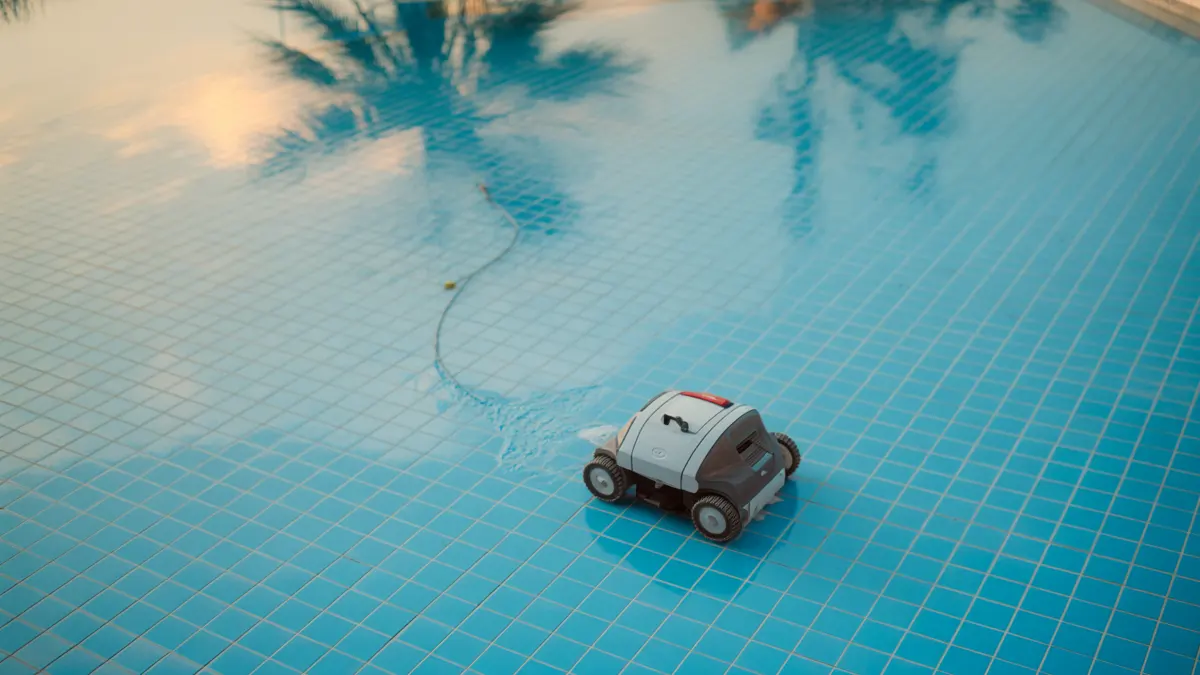
Crystal-clear water feels effortless only when a solid routine runs quietly in the background. Neglect a few steps and cloudy water, algae blooms or expensive equipment failures creep in.
The good news is that pool care breaks down into predictable weekly checks, deeper monthly tasks, and a handful of seasonal projects. Use the schedules below, and you will spend more hours swimming than scrubbing.
Why Routine Pool Care Matters
A balanced pool is safer for swimmers, kinder to equipment, and cheaper to run. Industry guides boil upkeep down to the “three” Cs”—circulation, cleaning, and chemistry—and recommend running the pump 8-12 hours a day to keep water moving.
Weekly Pool Maintenance Checklist
Skim and Remove Debris
Floaters such as leaves and insects become slimy sinkers within a day or two, so pass a leaf net across the surface every time you’re outside. Daily skimming reduces the load on the filter and prevents staining.
Brush Walls and Steps
Algae starts as a thin film on rough, low-flow spots. Brush steps, water-line tile, and corners once or twice a week; it is faster than fighting a bloom later.
Vacuum the Floor
Manual or robotic vacuums pick up grit that brushing loosens. Aim for a full-pool vacuum at least once a week, or more often after storms and pool parties.
Test and Balance Water Chemistry
Use strips or a liquid kit to check pH, total alkalinity, sanitizer, and stabilizer levels. Ideal targets for a chlorine pool are:
- pH 7.2-7.6
- Alkalinity 80-120 ppm
- Free chlorine 1-3 ppm
- Calcium hardness 200-400 ppm
Adjust small amounts at a time and retest in 30 minutes.
Shock When Needed
If heavy rain, heavy use, or an off-smell appears, add a shock dose of sanitizer to oxidize contaminants. Most backyard pools need shocking every one to two weeks during peak season.
Monthly Deep Maintenance
Inspect and Clean the Filter
Whether you own a cartridge, sand or DE filter, backwash or hose it clean whenever the pressure gauge reads 8-10 psi above the clean baseline. A thorough clean once a month keeps flow rates high and energy costs down.
Flush Plumbing Lines
Set the valve to backwash or waste, pull the pump strainer basket, then run the system until clear water exits. This quick job purges fine debris that clogs pipes over time.
Deep-Clean Skimmer and Pump Baskets
Debris that lodges in baskets forces the pump to work harder and shortens seal life. Empty both baskets, rinse them, and check the o-rings for wear.
Recheck Water Balance
Minerals such as calcium hardness and cyanuric acid drift slowly. Perform a full test kit once a month and record the values. Trend lines help you spot problems before they bite.
For more insight into the ongoing costs associated with pool upkeep, including maintenance expenses, check out this detailed guide on how expensive pool maintenance can be.
Seasonal Tasks
Opening Your Pool in Spring
- Remove and store the cover. Rinse, dry, and fold it to keep mold away.
- Refill to the mid-skimmer level if evaporation lowered the waterline.
- Reconnect equipment and inspect pump seals, O-rings, and fittings for cracks.
- Run the system for 24 hours while brushing and vacuuming to remove winter debris.
- Balance chemicals in stages, waiting at least six hours between each adjustment.
Mid-Season Upkeep
Hot weather and long swim days chew through chlorine quickly, so test every other day during midsummer. Consider running the pump an extra hour per 5 °F rise in air temperature.
Closing or Winterizing
Where freezing occurs, drop the water level below the skimmer, blow out lines, add winterizing chemicals, and install a safety cover. In warm regions, closing may simply mean reducing pump run time and watching rainfall dilution.
Troubleshooting Common Issues
Cloudy Water
Check filter pressure first. If high, backwash. Then test pH and sanitizer; both drifting low allow suspended particles to thrive. A clarifier or flocculant can clump fine debris for easier removal.
Algae Bloom
Green walls mean sanitizer has fallen below killing power. Brush aggressively, shock to breakpoint level (ten times the combined chlorine reading), and run the pump nonstop until water clears. Persistent blooms may indicate high phosphates; specialized removers can help.
Enjoy More Swim Time With Expert Backup
A systematic schedule keeps pool water sparkling, equipment humming, and ownership costs low. Still, life happens, and some weeks you may prefer to relax rather than lug a vacuum hose. That is where Pool R US can step in. Their certified technicians can handle weekly testing, monthly filter service, or full seasonal openings and closings, tailoring a plan to your budget while guaranteeing a swim-ready pool whenever you are.